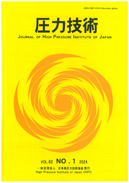巻号一覧

62 巻 (2024)
- 1 号 p. 4-
前身誌
最新号
選択された号の論文の3件中1~3を表示しています
- |<
- <
- 1
- >
- >|
論文
-
Takanori SUGIYAMA, Yoshihiro MIZUTANI2024 年 62 巻 1 号 p. 4-27
発行日: 2024年
公開日: 2024/02/23
ジャーナル フリーIn this study, an optimization method was developed to mini-mize the thickness of the cylindrical part of a carbon fiber reinforced plastic (CFRP)-composite overwrapped pressure vessel (COPV). This study extends the stress calculation equation of a pressure vessel with two layers subjected to internal pressure to multiple layers. This approach allowed the approximation of stress in each layer of the COPV with arbitrary stacking sequences and numbers of layers, reducing the computational costs. In this calculation method, only the strength of the cylindrical part of the COPV was considered. The stacking sequence was optimized to minimize the vessel thickness and maximum stress in the fiber direction under the condition that the inner diameter and thickness of a CFRP layer were constant. The optimization results show that the proposed method is reasonable because the stacking sequence is thinner than the existing tank stacking sequence. This omits the low-angle helical layer necessary to fabricate the dome part. Using the proposed method, we determined the possibility of optimizing the stacking sequence under arbitrary limiting conditions at a low computational cost. This study enables adding the allowable pressure for each damage mode (matrix cracking and fiber failure) to the limiting conditions or method optimization considering the strength development rate of fiber.抄録全体を表示PDF形式でダウンロード (2856K) -
竹本 真一郎, 吉川 暢宏, 横山 卓矢2024 年 62 巻 1 号 p. 28-36
発行日: 2024年
公開日: 2024/02/23
ジャーナル フリーThe goal of this research is to build a system that can easily and quickly find an optimum design of low-cost composite hydrogen tank of plastic liner called Type 4 by automatic calculation. We have proposed a method to search for the optimum design that minimizes the CFRP mass while ensuring the bursting strength by means of the machine learning which handles a large amount of finite element analysis data on tank specifications and their burst strength with wide range of various design variables. It is necessary to improve an accuracy of the finite element analysis by the axisymmetric model used for machine learning. We derive adequate criteria on rupture of carbon fiber in comparison with mesoscale model analyses where fiber bundle and resin are distinguished to represent meso-scale structure. We demonstrate an optimum design search of the Type 4 tank for fuel cell vehicles to verify the validity of the proposed method using a genetic algorithm for random search.抄録全体を表示PDF形式でダウンロード (1237K) -
飴矢 拓泰, 石崎 陽一2024 年 62 巻 1 号 p. 37-45
発行日: 2024年
公開日: 2024/02/23
ジャーナル フリーAPI579-1/ASME FFS-1 Fitness-for-Service Part 4 and Part 5 Lv.1 and Lv.2 as well as WES 2820 metal loss assessment procedure requires a certain dis-tance from a major stress discontinuity. It limits the FFS assessment often, however, the definition of major structural discontinuities shown in API579-1/ASME FFS-1 Part 4 and Part 5 as well as WES 2820 metal assessment is qualitative. Also, current requirement is based on Timoshenko’s model that assumed an external force and moment working on the surface of cylinder while some of “major structural discontinuity” would not take a significant force and moment. Improving the definition of “major structural discontinuity” would increase the application slot of API579-1/ASME FFS-1 Part 4 and Part 5 Lv.1 and Lv.2 assessment as well as WES 2820 metal loss assessment. In this paper, the remaining strength of pressure vessels with a locally thin area located around structural discontinuities is obtained and discussed for several typical cases, such as 2:1 elliptical head, hemisphere head and stiffening ring, based on the significance of surface correction factor Ms. The result indicated if the cross section of major structural discontinuity was sufficient and no working force and moment on it, it would not affect the remaining strength of pressure boundary.抄録全体を表示PDF形式でダウンロード (1210K)
- |<
- <
- 1
- >
- >|